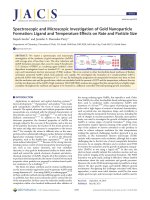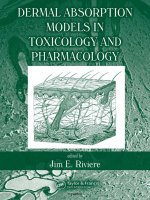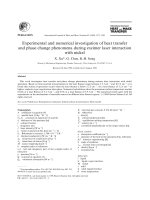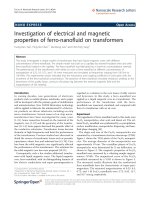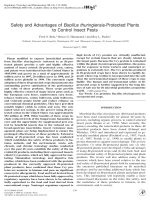Toxicology and pharmacology investigation of 2 phenylaminophenylacetic acid derived NSAIDs implication of chemical structure on biological outcomes
Bạn đang xem bản rút gọn của tài liệu. Xem và tải ngay bản đầy đủ của tài liệu tại đây (3.63 MB, 280 trang )
TOXICOLOGY AND PHARMACOLOGY
INVESTIGATION OF
2-PHENYLAMINOPHENYLACETIC ACID
DERIVED NSAIDS: IMPLICATION OF CHEMICAL
STRUCTURE ON BIOLOGICAL OUTCOMES
PANG YI YUN
(B.A.Sc. Food Sci. & Tech. (Hons.), NUS)
A THESIS SUBMITTED FOR THE DEGREE OF
DOCTOR OF PHILOSOPHY
DEPARTMENT OF PHARMACY
NATIONAL UNIVERSITY OF SINGAPORE
2014
DECLARATION
I hereby declare that the thesis is my original work and it has been written by
me in its entirety.
I have duly acknowledged all the sources of information which have been used
in the thesis.
This thesis has also not been submitted for any degree in any university
previously.
_________________
Pang Yi Yun
20 January 2014
Acknowledgements
First and foremost, I want to thank my supervisor, Dr. Ho Han Kiat for his
guidance, encouragement and support throughout these years. The course of
my research had been an invaluable and enjoyable experience and I thank him
for making it so. This thesis would not had been be possible without his advice
and insights into the research topic.
I would also like to thank my co-supervisor, Assoc. Prof. Go Mei Lin for her
advice and support, especially during the synthesis part of my project. Without
her encouragement and help, I would not had been able to complete the
synthesis of my compounds successfully.
I want to extend special thanks to several people who have helped me
immensely during the course of my research. Firstly, I would like to thank Dr.
Yeo Wee Kiang for his help in the in silico experimental parts of the project.
Many thanks to Dr. Yang Tianming and Dr. Wee Xi Kai for their patience in
teaching me essential synthetic skills. I want to thank Ms. Winnie Wong for
her guidance in biological assays. Also, many thanks to Ms. Yap Siew Qi and
Ms. Tan Yee Min for their guidance on mass spectroscopy techniques. Last
but not least, I would like to thank Assoc. Prof. Christina Chai and Assoc. Prof.
Seng Han Ming for their advice and guidance as part of my thesis committee.
Many thanks to the current and past members of the Laboratory of Liver
Cancer and Drug-Induced Liver Research for their friendship, support and
sharing of knowledge and research: Ms. Phua Lee Cheng, Ms. Tan Cheau Yih,
Ms. Angie Yeo, Ms. Zhao Chunyan, Ms. Chew Yun Shan and Ms. Sheela
David Packiaraj. I would also like to extend my thanks to past and present
members of Prof. Go’s laboratory: Ms. Tan Kheng Lin, Ms. Chen Xiao and Dr.
Pondy Murgappan Ramanujulu. To other fellow students and friends from the
Department of Pharmacy, thank you for all the help and support you have
provided throughout these years! Appreciation goes to my final year student,
Mr. Loh Kep Yong for his dedication and help in my project. Gratitude goes to
Mr. Johannes Murti Jaya, Ms. Ng Sek Eng, Mdm Oh Tang Booy and the rest
of the technical staff at the Department of Pharmacy for making research
easier with their help in purchasing of consumables and trouble-shooting of
machines.
I would like to acknowledge the financial support for my graduate studies
from the National University of Singapore Research Scholarship.
Many thanks to all my friends and relatives throughout the world. Their
support and encouragement has enabled me to carry on with my research. Last
but not least, I would like to give my heartfelt thanks and gratitude to my dad,
my mom and my sister. This journey would not had been possible without
their constant support, encouragement and cheering.
i
Table of Contents
Summary viii
List of Tables x
List of Figures xiii
List of Schemes xviii
List of Abbreviations xix
Chapter 1. Introduction 1
1.1. Adverse drug reactions – drug-induced liver injury (DILI) 1
1.2. Metabolism and its role in DILI 4
1.3. NSAIDs – Mechanism of action and induced liver injury 12
1.4. Comparison of non-selective NSAID (Diclofenac) and COX-2 selective
NSAID (Lumiracoxib) 14
1.5. Statement of purpose 19
Chapter 2. Design and Synthesis of 2-Phenylaminophenylacetic Acid
Derived Compounds 22
2.1. Introduction 22
2.2. Experimental methods 23
2.2.1. Extraction of diclofenac (3) from Voltaren tablets 24
2.2.2. Synthesis of compounds 1, 2 and 4 25
2.2.2.1. Synthesis of 2-iodophenyl-N, N-dimethylacetamide (25) 25
2.2.2.2. General procedure for the synthesis of 2-[(2,6-disubstituted
phenyl)amino)phenyl-N,N,-diethylacetamides (26 - 28) 26
2.2.2.3. General procedure for hydrolysis of acetamide to free acid (1, 2
and 4) 26
2.2.3. Synthesis of compounds 5 – 8 27
2.2.3.1. General procedure for the syntheses of 2,6-disubstituted-N-(p-
alkyl)anilines (29 – 48) 28
ii
2.2.3.2. General procedure for the syntheses of N-acetylated 2,6-
disubstituted-N-(p-tolyl)anilines (49 – 52) 28
2.2.3.3. General procedure for the syntheses of 1-(2,6-disubstituted)-5-
methylindolin-2-ones (53 – 56) 29
2.2.3.4. General procedure for the syntheses of 2-(2-(2,6-
disubstitutedphenyl)amino)-5-methylphenyl)acetic acid (5 – 8) 29
2.2.4. Synthesis of compounds 9 – 24 30
2.2.4.1. General method for the synthesis of 1-(2,6-disubstituted phenyl)-
5-ethylindoline-2,3-diones (57 - 72) 30
2.2.4.2. General method for the syntheses of 2-(2-(2,6-
disubstitutedphenyl)amino)-5-alkylphenyl)acetic acid (9 – 24) 31
2.2.5. Purity determination by HPLC 32
2.3. Discussion 32
2.4. Conclusion 41
Chapter 3. In vitro toxicity of 2-Phenylaminophenylacetic Acid derived
Compounds in Liver Cell Lines: Effect of Substituents on Toxicity and
Derivation of Quantitative Structure-Toxicity Relationships (QSTR) 42
3.1. Introduction 42
3.2. Experimental methods 43
3.2.1. Cell culture 43
3.2.2. Determination of key cytochrome P450 enzyme activities 44
3.2.3. MTT assay to determine cytotoxicity 45
3.2.4. Calculation of molecular descriptors 45
3.2.5. Selection of relevant molecular descriptors 46
3.2.6. QSTR models: Multiple linear regression and validation 46
3.2.7. Partial order ranking 47
3.2.8. Hasse diagram technique 48
3.2.9. Statistical Analysis 49
3.3. Results 49
iii
3.3.1. Determination of key cytochrome P450 activities 49
3.3.2. Effect of structural changes on toxicity 50
3.3.3. Effect of cell lines with varying metabolic competencies 55
3.3.4. QSTR models: Multiple linear regression and validation 56
3.4. Discussion 60
3.4.1. Comparison of cell lines 61
3.4.2. Effect of substituents on toxicity – relationship with lipophilicity
63
3.4.3. Halogen substituents and their role in drug design 66
3.5. Conclusion 68
Chapter 4. Inhibitory Effects of Synthesized Compounds on COX
Expressing Cell Lines: Potency, Selectivity and Elucidation of Structure-
Activity-Toxicity Relationships 70
4.1. Introduction 70
4.2. Experimental methods 71
4.2.1. Cell culture 71
4.2.2. Western blot to determine expression of COX enzymes in cell lines
72
4.2.2.1. Cell harvesting and lysis 72
4.2.2.2. SDS-PAGE and Transfer 72
4.2.2.3. Detection 73
4.2.3. Cell-based COX-1 inhibition assay 73
4.2.4. Cell-based COX-2 inhibition assay 73
4.2.5. In silico docking of compounds to crystallized COX isoforms 74
4.3. Results 75
4.3.1. Expression of COX enzymes in cell lines 75
4.3.2. Activity and selectivity of synthesized compounds 76
iv
4.3.3. In silico docking scores 82
4.3.4. Lipophilicity and effect on inhibitory potency of the compounds . 86
4.4. Discussion 87
4.4.1. Effect of substituents on inhibitory effect and safety of the
compounds
87
4.4.2. Lipophilicity and its effect on inhibitory potency 94
4.5. Conclusion 96
Chapter 5. Investigations of the Role of Metabolism in the Toxicity of the
Synthesized compounds: Effect of Substituents on Metabolic Stability and
Metabolite Reactivity, and the Relationships between Metabolic Stability,
Metabolite Reactivity and Toxicity 99
5.1. Introduction 99
5.2. Experimental methods 101
5.2.1. Microsomal incubation for Phase I metabolic stability assay 101
5.2.2. Microsomal incubation for Phase II metabolic stability assay 102
5.2.3. Microsomal incubation for AG reactivity 102
5.2.3.1. Incubation for AG formation 102
5.2.3.2. AG-Phe-Lys formation with biosynthesized AGs 103
5.2.4. LC-MS/MS analysis 103
5.2.4.1. LC-MS/MS analysis for metabolic stability assays 103
5.2.4.2. LC-MS/MS analysis for AG reactivity 105
5.2.5. Cell-based GSH depletion assay using TAMH cells 106
5.2.6. Linear regression for relationship investigation of metabolic
stability, reactivity and toxicity 107
5.3. Results 108
5.3.1. Metabolic stability of compounds towards Phase I and Phase II
metabolism 108
v
5.3.1.1. Effect of changes in substituents on Phase I metabolic stability
109
5.3.1.2. Effect of changes in substituents on Phase II metabolic stability
111
5.3.1.3. Inter-comparison between Phase I and Phase II metabolic stability
and their relationship with lipophilicity 114
5.3.2. In vitro GSH depletion of the compounds in TAMH cells 115
5.3.3. Reactivity of AGs of the compounds towards Phe-Lys 119
5.3.4. Relationship between metabolic stability and metabolite reactivity
122
5.3.5. Relationship between metabolic stability and toxicity 125
5.3.6. Relationship between reactivity and toxicity 127
5.4. Discussion 129
5.4.1. Phase I and Phase II metabolic stability 129
5.4.2. Reactivity of metabolites generated via metabolism 136
5.4.3. Role of metabolic stability and metabolite reactivity in toxicity of
the compounds 143
5.5. Conclusion 145
Chapter 6. Investigations of the Role of Metabolism in the Toxicity of the
Synthesized Compounds: Structure Elucidation of Trapped Reactive
Metabolites and Proposition of Possible Bioactivation Pathways 149
6.1. Introduction 149
6.2 Experimental methods 151
6.2.1. Microsomal incubation for Phase I reactive metabolites trapping
with GSH 151
6.2.2. Microsomal incubation for Phase II reactive metabolites trapping
with Phe-Lys 151
6.2.3. LC-MS/MS for identification of Phase I GSH trapped metabolites
152
6.2.3.1. LC-MS/MS for identification of Phase II Phe-Lys trapped
metabolites 154
vi
6.3. Results 155
6.3.1. Structure elucidation of Phase I GSH trapped reactive metabolites
for selected compounds 155
6.3.2. Structure elucidation of Phase II Phe-Lys trapped reactive
metabolites for selected compounds 178
6.4. Discussion 185
6.4.1. Structure elucidation and possible bioactivation pathways of Phase
I GSH trapped reactive metabolites for selected compounds 185
6.4.2. Structure elucidation and possible bioactivation pathways of Phase
II Phe-Lys trapped reactive metabolites for selected compounds 192
6.5. Conclusion 195
Chapter 7. Conclusion and Future Work 199
Bibliography 209
Appendix 222
Appendix 2-1: Complete structures of all twenty-four synthesized
compounds 222
Appendix 2-2: Characterization of synthesized compounds (1 – 24) and
imtermediates (25 – 72) 223
Appendix 2-3: Purities of compounds 1 – 24 as determined by HPLC at 280
nm (two gradients) 236
Appendix 3-1a: Partial ranking (Hasse diagram) of the twenty-four
compounds in TAMH cells 237
Appendix 3-1b: Partial ranking (Hasse diagram) of the twenty-four
compounds in HuH-7 cells 238
Appendix 3-2a: QSTR regression statistics for TAMH cells 239
Appendix 3-2b: QSTR regression statistics for HuH-7 cells 240
Appendix 4-1: Recipes for Western-Blot buffers and gels 241
Appendix 4-2: Docking poses of all twenty-four compounds in COX-1 and
COX-2 243
vii
Appendix 4-3: Log D(o/w) value calculated using online ACD/I-Lab
prediction engine 248
Appendix 5-1: Precursor and product ions utilized for MRM analysis in
determination of Phase I and Phase II metabolic stability 249
Appendix 5-2: List of masses used for SIM analysis. Selection was based
on nominal mass and tailored for negative ESI mode 251
Appendix 5-3: Representative mass spectrum and linear regression model
for determination of Phase I and Phase II metabolic stability 252
Appendix 5-4: Linear regression models for metabolite reactivity and
metabolic stability relationships for Phase I and Phase II metabolism 253
Appendix 5-5: Linear regression models for toxicity and metabolic stability
relationships for Phase I and Phase II metabolism 254
Appendix 5-6: Linear regression models for toxicity and metabolite
reactivity relationships for Phase I and Phase II metabolism 255
Appendix 6-1: Phase II reactive metabolite trapping - XIC traces of selected
compounds 256
viii
Summary
The aim of this thesis was to test the hypothesis that varying substituents on
the 2-phenylaminophenylacetic acid scaffold, of which diclofenac and
lumiracoxib were derived from, will affect bioactivation and subsequently,
toxicity to a significant degree. We also aimed to study how these subtle
changes to substituents on the given chemical scaffold affect the intricate link
between toxicity and pharmacology, providing an opportunity to optimize
drug safety and efficacy.
Twenty-four 2-phenylaminophenylacetic acid derived compounds with
varying substituents at three critical pharmacophores were synthesized. The
compounds were subjected to in vitro cytotoxicity testing on two liver cell
lines of contrasting metabolic competencies. We observed higher toxicity in
the more metabolically competent cell line. We have also shown that structural
changes on the chemical scaffold exerted pronounced effect on liver
cytotoxicity. Thereafter, we developed a quantitative-structure-toxicity
relationship (QSTR) model which unveils the trend of increasing lipophilicity
in the cellular manifestation of toxicity. A concurrent determination of their
pharmacological activity using COX inhibition assays allowed us to derive a
safety profile, which showed that selectivity towards COX-2 negatively
affected activity and in some cases, toxicity.
In order to probe further into the toxicity caused by bioactivation, we carried
out a series of metabolic assays. We measured the Phase I and Phase II
metabolic stability of the compounds separately. We observed that the most
ix
toxic compound was not the least stable compound. In fact, the toxicity of the
compounds is not intricately linked to their metabolic stabilities. Given this
interesting observation, we decided to determine the reactivity of the Phase I
and Phase II metabolites formed from the compounds. We observed that the
more toxic compounds produced more reactive metabolites regardless of the
compound’s metabolic stability, especially in the case of Phase I metabolism.
Last but not least, we carried out trapping assays to elucidate possible
structures of the reactive metabolites via LC-MS/MS and to investigate
possible bioactivation pathways. We elucidated several possible structures of
the Phase I and Phase II reactive metabolites and their possible bioactivation
pathways. In addition, we observed that the varying substituents do affect the
structures and amount of reactive metabolites formed but further experiments
need to be carried out. On the other hand, we observed that substituents have
no effect on the structures of Phase II reactive metabolites.
In conclusion, the findings of this thesis supported our hypothesis that varying
substituents on the 2-phenylaminophenylacetic acid scaffold, will affect
bioactivation and subsequently, toxicity to a significant degree. In addition, we
also elucidated a possible relationship between toxicity and pharmacology,
which provided a better understanding in the balance between toxicity and
activity and presents the possibility to associate the two biological outcomes.
(437 words)
x
List of Tables
Table 1-1 Routes of elimination of marketed drugs 4
Table 1-2 Examples of hard and soft electrophiles and hard and soft
nucleophiles 6
Table 1-3 Abundance of CYP enzymes in the human liver and their possible
substrates 7
Table 3-1 LC
50
values and calculated descriptors of the twenty-four
compounds 51
Table 3-2 Ratios of LC
50
values between substitutions at R
1
: H and R
1
: tert-
butyl 55
Table 3-3 The predicted and the experimental -log(TAMH LC
50
) and -
log(HuH-7 LC
50
) values of the twenty-four compounds 58
Table 4-1 COX median inhibitory concentration (IC
50
), selectivity index and
safety index of the twenty-four synthesized compounds 77
Table 4-2 Comparison of potency ranking of compounds with literature data
80
Table 4-3 In silico docking scores for the synthesized twenty-four compounds
83
Table 5-1 LC conditions for Agilent 1290 Infinity LC system + Agilent 6430
Triple Quadrupole MS and Agilent 1290 Infinity LC system + AB Sciex Qtrap
® 5500 104
Table 5-2 MS source parameters for Agilent 6430 Triple Quadrupole MS and
AB Sciex Qtrap ® 5500 105
Table 5-3 LC conditions for AG reactivity analysis 106
xi
Table 5-4 MS source parameters for AG reactivity analysis 105
Table 5-5 Phase I and Phase II microsomal metabolic t
1/2
of the twenty-four
compounds 108
Table 5-6 In vitro GSH depletion (%) for the twenty-four compounds in
TAMH cells 116
Table 5-7 Reactivity of AGs of the twenty-four compounds toward Phe-Lys in
a 24 h incubation 120
Table 5-8 Physicochemical parameters of halogen substituents employed in
our study 132
Table 5-9 Physicochemical parameters of alkyl substituents employed in our
study 133
Table 6-1 LC conditions for Phase I GSH trapped metabolites identification
153
Table 6-2 MS source parameters for Phase I GSH trapped metabolites
identification 153
Table 6-3 LC conditions for Phase II Phe-Lys trapped metabolites
identification 154
Table 6-4 MS source parameters for Phase II Phe-Lys trapped metabolites
identification 155
Table 6-5 Proposed structures and fragmentation pathways for GSH-trapped
metabolites of compound 1 165
Table 6-6 Proposed structures and fragmentation pathways for GSH-trapped
metabolites of compound 3 (diclofenac) 166
Table 6-7 Proposed structures and fragmentation pathways for GSH-trapped
metabolites of compound 5 (lumiracoxib) 168
xii
Table 6-8 Proposed structures and fragmentation pathways for GSH-trapped
metabolites of compound 6 170
Table 6-9 Proposed structures and fragmentation pathways for GSH-trapped
metabolites of compound 7 171
Table 6-10 Proposed structures and fragmentation pathways for GSH-trapped
metabolites of compound 8 172
Table 6-11 Proposed structures and fragmentation pathways for GSH-trapped
metabolites of compound 9 173
Table 6-12 Proposed structures and fragmentation pathways for GSH-trapped
metabolites of compound 13 174
Table 6-13 Proposed structures and fragmentation pathways for GSH-trapped
metabolites of compound 17 175
Table 6-14 Proposed structures and fragmentation pathways for GSH-trapped
metabolites of compound 21 176
Table 6-15 Proposed structures and fragmentation pathways for GSH-trapped
metabolites of compound 23 177
Table 6-16 Proposed structures and fragmentation pathways for GSH-trapped
metabolites of compound 24 178
Table 6-17 Proposed structures and fragmentation pathways for Phe-Lys-
trapped metabolites of five selected compounds 183
xiii
List of Figures
Figure 1-1 Six mechanisms of liver injury 3
Figure 1-2 Hydroxylated aromatic rings can undergo a further two electron
oxidation to reactive electrophiles 8
Figure 1-3 Redox cycling of benzoquinones produces ROS which causes
oxidative damage 9
Figure 1-4 AGs can undergo transacylation or acyl migration (2-β-O-, 3-β-O-,
4-β-O-) followed by glycation 11
Figure 1-5 Production of prostanoids by COX-1 and COX-2 from arachidonic
acid and their respective target tissue/organ 13
Figure 1-6 Phase I metabolic pathway of diclofenac by CYP2C9 and
CYP3A4 and subsequent possible bioactivation 15
Figure 1-7 Formation of covalent adducts by diclofenac-1-β-O-acyl
glucuronide through transacylation or acyl migration 16
Figure 1-8 Numbering of aromatic rings of lumiracoxib 17
Figure 1-9 Phase I metabolism pathway and subsequent bioactivation and
conjugation of nucleophiles for lumiracoxib 18
Figure 2-1 Structures of target compounds synthesized with position R
1
on
ring A and positions R
2
and R
3
on ring B 22
Figure 2-2 Mechanism of the formation of an amide via formation of an acid
chloride 33
Figure 2-3 Mechanism of Ullmann condensation 34
Figure 2-4 Mechanism of Buchwald-Hartwig coupling (X: Br, I) 36
xiv
Figure 2-5 Mechanism for intramolecular Friedel-Crafts alkylation 37
Figure 2-6 Mechanism of Friedel-Crafts acylation 38
Figure 2-7 (a) H
1
NMR spectrum of compound 10 acetamide; (b) H
1
NMR
spectrum of compound 10 oxindole; (c) [M+H]
+
of compound 10 oxindole 39
Figure 2-8 Mechanism of reverse Friedel-Crafts 40
Figure 2-9 Mechanism of a modified Wolff-Kishner reduction 41
Figure 3-1 Comparison between the relative luminescence units (RLU)
obtained for HuH-7 and TAMH for (a) CYP2C9 and (b) CYP3As 50
Figure 3-2 The Hasse diagram of the twenty-four compounds investigated in
this study 53
Figure 3-3 Plot of LC
50
values of HuH-7 against TAMH for all compounds 56
Figure 3-4 Predicted −log(LC
50
) versus experimental −log(LC
50
) for (a)
TAMH (R
2
= 0.6641) and (b) HuH-7 (R
2
= 0.458) 59
Figure 3-5 (a) Plot of –log(LC
50
) against log P(o/w) for TAMH and (b) Plot of
–log(LC
50
) against FASA_H for HuH-7 60
Figure 4-1 Western blot of HEL92.1.7 and RAW264.7 75
Figure 4-2 Comparison plots for IC
50
values for COX-1 and COX-2 obtained
from cell-based COX inhibition assays for (a) F-Cl series; (b) F-F series; (c)
Cl-Cl series and (d) Br-Br series 78
Figure 4-3 Docking pose of diclofenac and compound 7 in COX-1 co-
crystallized with acclofenac as ligand 84
Figure 4-4 Docking pose of diclofenac and compound 7 in COX-2 co-
crystallized with diclofenac ligand 85
xv
Figure 4-5 Plot of Log IC
50
(nM) against log P(o/w) of the compounds for
COX-1 and COX-2 for compound series (a) F-Cl; (b) F-F; (c) Cl-Cl and (d)
Br-Br 86
Figure 5-1 Comparison plot for Phase I metabolic stability between halogen
substituents at R
2
and R
3
grouped by R
1
substituents 109
Figure 5-2 Comparison plot for Phase I metabolic stability between alkyl
substituents at R
1
and grouped by R
2
and R
3
substituents 110
Figure 5-3 Comparison plot for Phase II metabolic stability between halogen
substituents at R
2
and R
3
and grouped by R
1
substituents 111
Figure 5-4 Comparison plot for Phase II metabolic stability between alkyl
substituents at R
1
and grouped by R
2
and R
3
substituents 112
Figure 5-5 Comparison of Phase I (orange) and Phase II (blue) metabolic t
1/2
.
114
Figure 5-6 Comparison plot for GSH depletion between halogen substituents
at R
2
and R
3
grouped by R
1
substituents 117
Figure 5-7 Comparison plot for GSH depletion between alkyl substituents at
R
1
and grouped by R
2
and R
3
substituents 118
Figure 5-8 Comparison plot for AG reactivity between halogen substituents at
R
2
and R
3
and grouped by R
1
substituents 120
Figure 5-9 Comparison plot for AG reactivity between alkyl substituents at R
1
and grouped by R
2
and R
3
substituents 121
Figure 5-10 Comparison of Phase I average metabolic t
1/2
and in vitro GSH
depletion 123
Figure 5-11 Comparison of Phase II average metabolic t
1/2
and AG reactivity
(24 h). 124
xvi
Figure 5-12 Comparison of Phase I average metabolic t
1/2
and in vitro toxicity
in TAMH 125
Figure 5-13 Comparison of Phase II average metabolic t
1/2
and in vitro
toxicity in TAMH 126
Figure 5-14 Comparison of in vitro GSH depletion and corresponding in vitro
toxicity in TAMH 128
Figure 5-15 Comparison of AG reactivity and in vitro toxicity in TAMH 128
Figure 5-16 Hydroxylation at 4’-position and subsequent oxidation to a
quinone imine 137
Figure 5-17 Formation of an imine methide when R
1
is an alkyl group 139
Figure 5-18 Hydroxylation at 5-position and subsequent oxidation to a
quinone imine 142
Figure 6-1 TIC of negative PI scan of m/z 272 and the subsequent XIC trace
of the trapped metabolites for compound 3 (diclofenac) 156
Figure 6-2 XIC trace of GSH trapped metabolites of (a) compound 5; (b)
compound 6; (c) compound 7 and (d) compound 8 of the methyl series 157
Figure 6-3 XIC trace of GSH trapped metabolites of (a) compound 1; (b)
compound 9; (c) compound 13 and (d) compound 17 158
Figure 6-4 XIC trace of GSH trapped metabolites of (a) compound 21; (b)
compound 23 and (c) compound 24 159
Figure 6-5 EPI spectra for 3-RM2 (m/z 583) 160
Figure 6-6 Spectras of negative EMS full scan of compound 3 (diclofenac)
reactive AGs trapped with Phe-Lys 180
xvii
Figure 6-7 Spectras of negative EMS full scan of compound 5 (lumiracoxib)
reactive AGs trapped with Phe-Lys 182
Figure 6-8 Possible pathways for dehalogenation of quinone imines formed
with subsequent conjugation of GSH via (a) direct attack on chlorinated atom
or (b) ipso GSH addition 186
Figure 6-9 Possible pathways for GSH adduct formation from quinone imines
formed from the phenylacetic acid (Ring A) or the aniline ring (Ring B) 189
Figure 6-10 Possible pathways for GSH adduct formation from imine
methides formed from alkyl groups with an extractable hydrogen 190
Figure 6-11 Possible pathways for GSH adduct formation from ortho-imine
methides formed oxidative decarboxylation 190
Figure 6-12 Possible pathway for formation of 23-RM2 from dechlorination
followed by direct GSH conjugation via an ipso GSH addition mechanism . 191
Figure 6-13 Pathways involved in formation of AG adducts for the
synthesized compounds 193
Figure 6-14 Possible reactive metabolites and their GSH conjugates proposed
for our synthesized compounds 197
Figure 7-1 Possible reactive metabolites and their trapped conjugates
proposed for our synthesized compounds for both Phase I and Phase II
metabolism 204
xviii
List of Schemes
Scheme 2-1 Synthetic scheme for synthesis of 1, 2 and 4 25
Scheme 2-2 Synthetic scheme for synthesis of 5 – 8 27
Scheme 2-3 Synthetic scheme for synthesis of 9 – 24 30
xix
List of Abbreviations
1
H NMR Proton nuclear magnetic resonance spectrum
13
C NMR Carbon-13 nuclear magnetic resonance spectrum
(±)-BINAP
(±)-2,2’-Bis(diphenylphosphino)-1,1’-binaphthalene
ADRs Adverse drug reactions
AGs Acyl glucuronides
ANOVA Analysis of variance
BCA Bicinchoninic acid
CDCl
3
Chloroform, deuterated
CE Collision energy
COX Cyclooxygenase
CXP Collision cell exit potential
DCM Dichloromethane
DILI Drug-Induced Liver Injury
DMEM Dulbecco’s Modified Eagle’s Medium
DMEM/F12 Dulbecco’s modified Eagle’s medium/Ham’s F12
DMSO Dimethyl sulfoxide
DP Declustering potential
ELISA Enzyme-linked immunosorbent assay
EMS Enhanced mass scan
EP Entrance potential
EPI Enhanced product ion
ESI Electrospray ionization
EtOAc Ethyl acetate
FASA_H Fractional accessible surface area_hydrophobic
xx
FBS Fetal bovine serum
FDA U.S. Food and Drug administration
GSH Glutathione
HLM Human liver microsomes
HPLC High-performance liquid chromatography
IC
50
Median inhibitory concentration
IDA Information-dependent acquisition
LC
50
Median lethal concentration
LC-MS/MS Liquid chromatography-tandem mass spectroscopy
Log D(o/w) Calculated partition coefficient in water/octanol, pH 7.4
Log P(o/w) Calculated partition coefficient in water/octanol
LPS Lipopolysaccharides
MCB Monochlorobimane
MOE Molecular Operating Environment
MRM Multiple reaction monitoring
MTT 3-(4,5-Dimethylthiazol-2-yl)-2,5-diphenyltetrazolium
bromide
NAC N-acetylcysteine
NADP
+
Nicotinamide adenine dinucleotide phosphate
NAPQI N-acetyl-p-benzoquinone imine
NSAIDs Non-steroidal anti-inflammatory drugs
P450s Cytochrome P450 enzymes
PBS-T Phosphate buffered saline Tween-20
PDB Protein Data Bank
PGE
2
Prostaglandin E
2
Phe-Lys Phenylalanine-lysine dipeptide
xxi
PI Precursor ion
QSTR Quantitative structure-toxicity relationship
RLU Relative luminescence units
ROS Reactive oxygen species
SAR Structure-activity relationship
SDS-PAGE Sodium dodecyl sulfate polyacrylamide gel
electrophoresis
SIM Single ion mode
t
1/2
Metabolic half-lives
TIC Total ion chromatogram
TLC Thin layer chromatography
TXB
2
Thromboxane-B
2
UDPGA Uridine diphosphoglucuronic acid
UGTs Uridine disphosphate glucuronosyltransferases
WHO World Health Organization
XIC Extracted ion chromatogram
